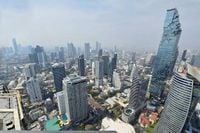A powerful earthquake measuring 8.2 on the Richter scale struck near Sapphaya District, Myanmar, on Friday, March 28, 2025, sending tremors felt across Bangkok. Despite the intensity of the quake, the incident has revealed the resilience of Thailand's high-rise buildings, as no significant structural failures were reported in the capital.
Bangkok Governor Chatichai Sitthiphanth stated that this earthquake marks the most substantial seismic activity in over a decade, prompting immediate inspections across the city. "The situation is beginning to stabilize, and our responsibility is to reassure the public that the buildings are safe," he explained.
According to the Bangkok Metropolitan Administration (BMA), all 5,994 high-rise buildings constructed since 2007 are reported to be 100% safe. The only structure that sustained damage was an unfinished office building belonging to the State Audit Office, which suffered minor cracks. This incident has drawn significant media attention, overshadowing the fact that all other high-rises remained intact.
Governor Sitthiphanth emphasized that the earthquake was a critical test of Thailand's construction standards, which have mandated earthquake-resistant designs since 2007. "It’s important to note that while the quake was severe, only one building was affected, and it was still under construction," he said.
In the aftermath, construction companies swiftly mobilized teams of engineers to assess their properties. Supalai Public Company Limited reported that they completed inspections of 89 projects by March 29, confirming that most buildings showed no significant structural damage. However, some architectural elements like tiles and walls had minor damages.
Uthai Uthaiangsuk, CEO of Sansiri Public Company Limited, echoed this sentiment, stating, "We have expedited inspections across all our condominium projects and found that all structures are safe and suitable for habitation. Our teams are working diligently to ensure any cosmetic damages are addressed promptly."
SC Asset Corporation also took immediate action, deploying teams to inspect all their projects, ensuring compliance with safety standards. Their CEO, Nattapong Kunakornwong, stated, "Safety is our utmost priority. We are committed to ensuring that residents can live without worry in all our developments."
Origin Property Public Company Limited's CEO Peerapong Jaroon-Ek personally oversaw inspections at the Park Origin Thonglor project, which experienced some damage. "Our engineering teams confirmed that the structural integrity remains intact, and we are addressing cosmetic repairs urgently," he noted.
In addition to these efforts, various developers announced initiatives to strengthen their response to such emergencies. Asset Wise Public Company Limited outlined a four-point plan focusing on immediate inspections, repair protocols, and communication channels for residents. Their CEO, Chatchai Wiphatphong, emphasized, "We are dedicated to ensuring our residents' safety and well-being during this time."
Meanwhile, the Lam Takhong Reservoir in Nakhon Ratchasima Province is facing a severe water crisis, with current levels at only 11% of its capacity. The reservoir serves as a vital water source for five districts, including Si Khiu and Mueang Nakhon Ratchasima. On April 2, 2025, officials reported that the reservoir holds just 56.13 million cubic meters of water, significantly below the required levels.
Despite recent rainfall from seasonal storms, only a minimal amount of water, approximately 15,000 cubic meters, has flowed into the reservoir. This situation poses challenges for water supply to households, agriculture, and industry in the region.
Officials from the Nakhon Ratchasima Irrigation Project are urging residents and farmers to conserve water as they navigate this drought. The project manager stated, "We must manage our water resources wisely to ensure everyone has enough supply until the rainy season arrives."
As the city and province recover from these dual crises, the focus remains on ensuring the safety and well-being of residents. The successful response to the earthquake has instilled confidence in the construction standards of high-rise buildings in Thailand, while the ongoing water management efforts highlight the importance of sustainability in the face of environmental challenges.
In conclusion, the earthquake not only tested the structural integrity of Thailand's buildings but also showcased the resilience of its construction regulations. As the nation moves forward, it is crucial to maintain these high standards while addressing other pressing issues, such as water scarcity.





